
If you depend on organic search traffic to maintain online visibility, then you should be familiar with one crucial part of the SEO marketing equation: the actual creation of SEO-friendly content.
Enter the skilled SEO copywriter, one who can craft compelling marketing content that’s properly designed and optimized to increase search engine visibility.
The demand for someone to fill such a role has risen significantly over the years, but the SEO copywriter’s job is unique: they must have a solid foundation of knowledge in the arena of copywriting, and be competent in the ever-evolving world of SEO best practices, knowing how to optimize the words they write to please the search engines.
This detailed and thorough guide will help you to get a better understanding of how their expertise is applied when building SEO-focused marketing campaigns.

SEO Copywriting Basics: Symbiotic Functions
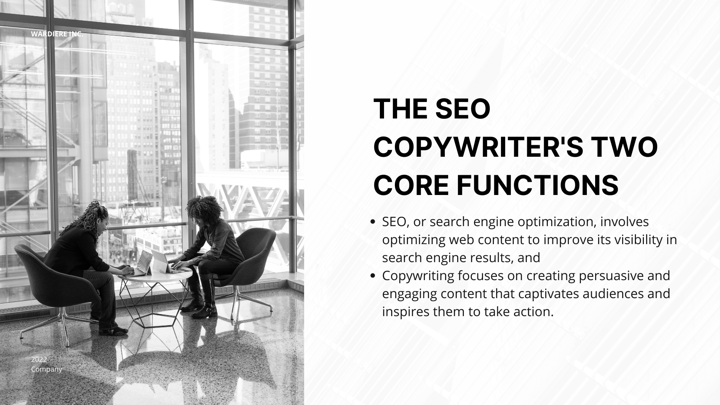
The SEO copywriter is a specialist, one whose job is made up of two core functions:
- SEO, or search engine optimization, involves optimizing web content to improve its visibility in search engine results, and
- Copywriting focuses on creating persuasive and engaging content that captivates audiences and inspires them to take action.
Weaving these two skills together is how the SEO copywriter designs marketing content that people want to consume while optimizing that content for search engine traffic.
This means the SEO copywriter must be highly competent in both areas.
Key Responsibilities of an SEO Copywriter
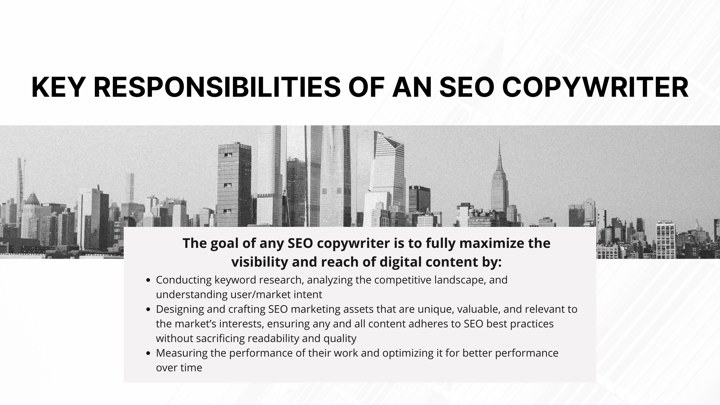
The goal of any SEO copywriter is to fully maximize the visibility and reach of digital content by:
- Conducting keyword research, analyzing the competitive landscape, and understanding user/market intent
- Designing and crafting SEO marketing assets that are unique, valuable, and relevant to the market’s interests, ensuring any and all content adheres to SEO best practices without sacrificing readability and quality
- Measuring the performance of their work and optimizing it for better performance over time
The SEO Copywriting Development Process Part One: Research & Analysis
Creating SEO-friendly content begins by understanding what valuable and relevant information is being sought out by a target audience and delivering it in the form of content that Google finds acceptable.
SEO copywriters optimize their chances of ranking higher in search engine results by strategically using specific keywords and phrases in the content they create to meet the target audience's search demands.
To gather the correct information, the first step in the SEO copywriting process is proper research and analysis.
Keyword Research
An SEO copywriter’s method of researching relevant keywords will vary, but the goal is simple: find the keywords and phrases of interest to your target audience, and form a content strategy based on factors like volume, competition, and relevance.
But the SEO copywriter must make use of other information that requires a closer look into their preferred keywords.
Keyword Variations & Related Terms
To create content that’s unique, the SEO copywriter can’t just stuff the most popular keywords into a blog post.
The SEO copywriter should understand the different keyword variations of a search query and other related terms.
Keyword variations are simply the various ways a user enters search engine queries related to your main keyword(s).
For example, someone searching for “how to fight a parking ticket” may also search for:
- can I fight a parking ticket?
- how to appeal a parking ticket
- is it worth it to fight a parking ticket?
Related terms are secondary terms related to your main keyword(s).
They are usually featured consistently within content about the keywords you want to rank for, or they are terms people search for that are closely related.
For example, search results for “the best protein powder” might include related terms such as:
- protein powder for weight loss
- protein powder for gaining muscle
- organic protein powders
- is protein powder healthy?
Search Intent
Keyword research will tell you what phrases and keywords people use when they’re searching for information, but the SEO copywriter must understand the intent of those searches.
And it's very important to how Google indexes your content.
Their quality guidelines heavily emphasize the importance of satisfying user intent, and they continue to report on the significance of understanding why someone is searching for something, as stated in this study that showed:
There are six canonical consumer needs: Surprise Me, Help Me, Reassure Me, Educate Me, Impress Me, and Thrill Me. Each need state is made up of a combination of emotional, social, and functional needs. Emotions are the foundations of need states. The truth is, decision-making is not a rational process, but one driven mainly by how people feel.
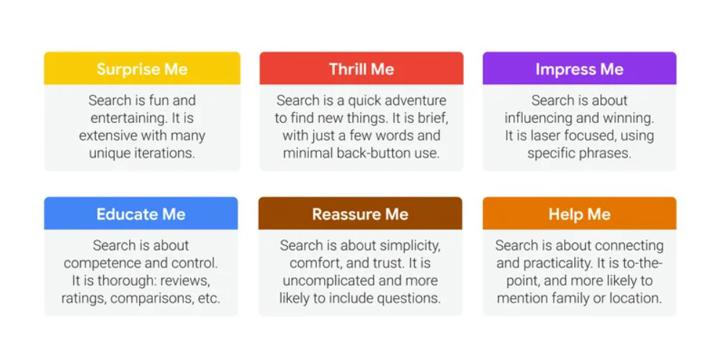
The SEO copywriter should know how the person searching for the preferred keywords and phrases intends to use that information, so they can give them the most valuable information possible.
For example, the person searching for “the best protein powder” likely doesn’t know much about protein powder, given the general nature of the query.
They’re beginners, for lack of a better term.
Content that satisfies their search intent would likely fall into the realm of “the best protein powder for beginners.”
Whereas the intent of someone searching for “organic protein powder for weight loss” should be satisfied with a different approach.
The Competitive Landscape
Competitor analysis offers insight into which types of content perform best, and how to design SEO assets for strong positioning.
The SEO copywriter must understand what’s currently working to rank high in Google’s search results, so they can create marketing content that performs effectively.
If infographics and ultimate guides are consistently used by the most visible competitors in your market, the SEO copywriter must strategize accordingly.
Are there opportunities in the marketplace for overlooked keyword variations or related phrases? Can the ranking leaders be outdone by creating better content for existing search terms, or by creating more? Or both? And what kind? In-depth case studies, step-by-step instructions, tips & tricks?
The SEO copywriter must know what they’re up against if they want to create content that will generate results.

SEO Copywriting Development Part Two: Design & Execution
The process of creating SEO-friendly content will make up the bulk of an SEO copywriter’s work.
And armed with all the information gathered during research, the SEO copywriter has the ability to design valuable and highly relevant content for the intended audience.
This is also the point at which the SEO copywriter must put both their core competencies into practice, leveraging each skill’s individual strengths to generate one overarching superpower!
What Kind Of Content Should The SEO Copywriter Create?
What kind of content the SEO copywriter will create depends on the strategic approach they decided upon after analyzing their research.
For example, the SEO copywriter may have decided to create one critical piece of mega content, with several supporting blog posts that capture relevant keyword variations and related phrases.
Or they may have decided to create a useful tool or strategy the market can implement and will be easy to share across other authoritative websites.
The strategy may be to create an ultimate guide or information hub, with in-depth descriptions that cover the full range of a popular topic.
A study designed to generate mainstream media attention on a particular subject of intense interest in a specific industry will require the creation of more than just a few 1,000-word blog posts—the research methodologies, report of findings, press releases, media outreach, landing page pathways, and other SEO-optimized assets will need to be built out.
It’s important that the SEO copywriter is clear on what exactly is needed to execute a particular strategy, and that they have the ability to deliver the types of content needed to do so.
Designing The Content Structure
This is where the traditional copywriting experience of the SEO copywriter will begin to shine.
All good copywriters know the importance of structuring their content. From how a blog post or guide is laid out from start to finish, to how the opening paragraph is written, a comprehensive outline of every SEO marketing asset should be designed and created.
The SEO copywriter should also consider common SEO factors such as bounce rate and time-on-site metrics when building out the initial content structure.
For example, to reduce a page’s bounce rate, the SEO copywriter should incorporate a strategy like the “User Validation Technique” to keep visitors engaged at the very beginning of a post.
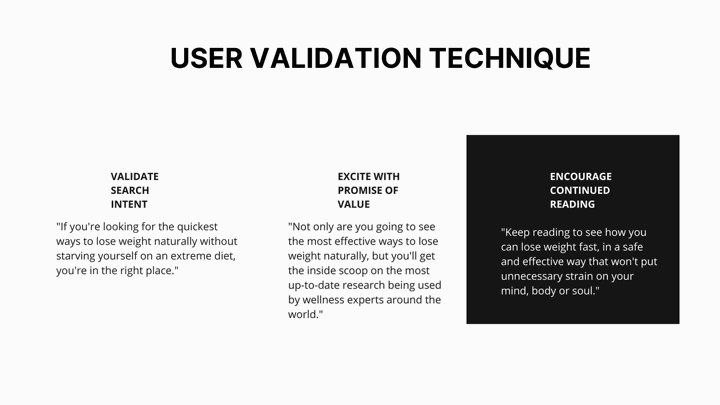
Or, the Persona Pathways Method, which gives visitors the ability to choose the most relevant part of a page based on their intent.

How The SEO Copywriter Creates Content Optimized For Search Engine Visibility
After the content structure is built, the SEO copywriter will use their copywriting knowledge to create engaging marketing assets that drive visitors to take the desired actions, while at the same time implementing SEO methods in order to please the search engines.
Most Valuable Copywriting Skills For An SEO Copywriter To Use
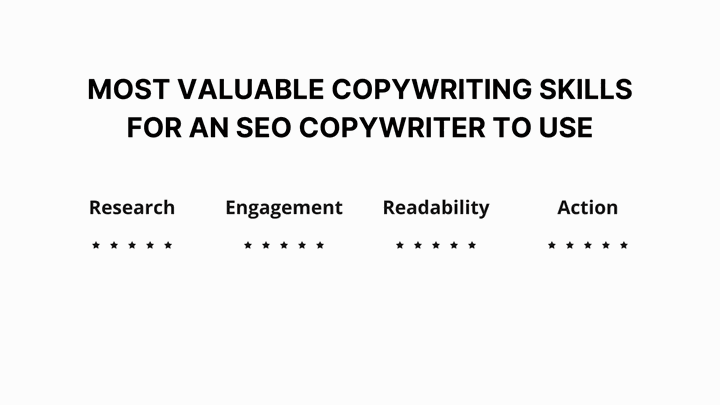
- Research: Copywriting depends heavily on research done at the front end of the project. Research findings play an important role in presenting facts, showcasing various sources of information, and communicating overall authority on a subject. The more prepared the copywriter is with a large pool of information to draw from during the process of creation the better. Headlines, subheaders, quotes, benefit bullets, and all other copywriting techniques can be quickly crafted by referencing research insights.
- Engagement: Keeping readers engaged is a necessary copywriting skill that should be employed in the creation of both short and long-form marketing assets. The ability of a copywriter to keep people reading will have a direct impact on how valuable Google deems your content to be. If visitors stay on your page longer and consume large amounts of your content when on your website, Google will log this as useful to the search intent of its users, and show your site to more people.
- Readability: The content created must be readable in a way that’s fluid, and clear to the person reading it. This means the grammatical structure should make the experience smooth, and the overall points you want to make should be easy for the user to understand. Avoid complex language, and make it as simple as possible for someone who’s not familiar with the subject to grasp.
- Action: Marketing copywriters who understand the basics of persuasion know how to move a person to take a desired action through their words. The SEO copywriter will need to drive a variety of actions, whether it’s a direct call to action for the purchase of a product, signing up to request a call with a salesperson, opting in for a mailing list, or simply adding a comment at the end of a blog post. The goal of all marketing is to draw the visitor closer to a business relationship with you in some way, and even actions as simple as someone bookmarking your content for later reading can be very valuable.
The SEO Basics A Copywriter Must Use To Optimize Content
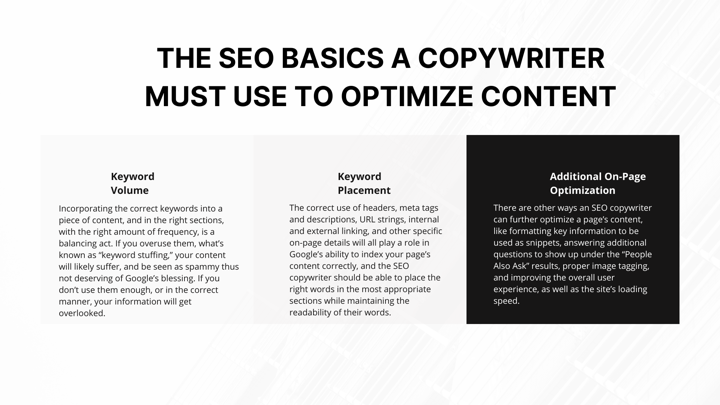
- Keyword Volume: Incorporating the correct keywords into a piece of content, and in the right sections, with the right amount of frequency, is a balancing act. If you overuse them, what’s known as “keyword stuffing,” your content will likely suffer, and be seen as spammy thus not deserving of Google’s blessing. If you don’t use them enough, or in the correct manner, your information will get overlooked. The frequency of keywords used on a page, and the chosen placement, will depend on a number of factors, and the SEO copywriter should first prioritize giving the reader the most valuable information possible, and once confident in having completed that task, then they can optimize the content for the proper keyword density and placement.
- Keyword Placement: The SEO copywriter should know the best practices of where and how to use keywords correctly. The correct use of headers, meta tags and descriptions, URL strings, internal and external linking, and other specific on-page details will all play a role in Google’s ability to index your page’s content correctly, and the SEO copywriter should be able to place the right words in the most appropriate sections while maintaining the readability of their words.
- Additional Optimization Tools: There are other ways an SEO copywriter can further optimize a page’s content, like formatting key information to be used as snippets, answering additional questions to show up under the “People Also Ask” results, proper image tagging, and improving the overall user experience, as well as the site’s loading speed.
SEO Copywriting Development Part Three: Off-Page SEO & Content Optimization
As with any marketing effort, measuring and analyzing the success of SEO copywriting is crucial. The SEO copywriter will want to see how their work performs in a number of different ways so they can optimize it to perform better over time.
They can also play a role in off-page activities, depending on their involvement in its strategy.
The SEO Copywriter’s Role In Off-Page SEO Strategy
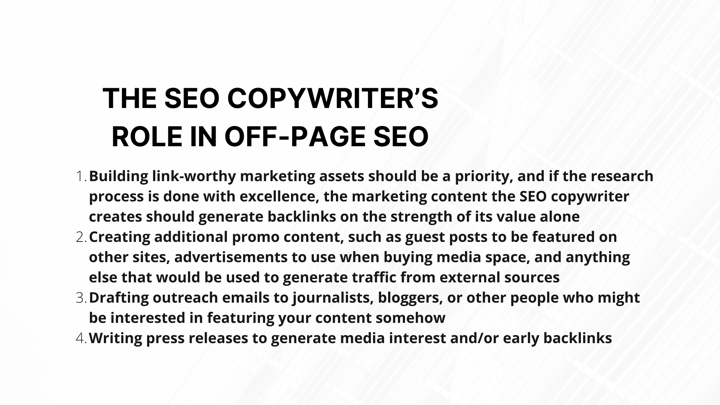
Off-Page SEO refers to anything done to increase the ranking of your website by external means, such as generating backlinks, content syndication (like guest posting), and increasing engagement on social media platforms.
The SEO copywriter can be involved in off-page SEO strategies in a few ways:
- Building link-worthy marketing assets should be a priority, and if the research process is done with excellence, the marketing content the SEO copywriter creates should generate backlinks on the strength of its value alone
- Creating additional promo content, such as guest posts to be featured on other sites, advertisements to use when buying media space, and anything else that would be used to generate traffic from external sources
- Drafting outreach emails to journalists, bloggers, or other people who might be interested in featuring your content somehow
- Writing press releases to generate media interest and/or early backlinks
Content Optimization For The SEO Copywriter
The way an SEO copywriter measures their work for its performance depends on the business’s overall goals.
For example, if a piece of content isn’t generating huge amounts of traffic, but the average time a user spends on it is very high, and it’s leading to a valuable conversion such as email subscribers, then it’s safe to say that it is performing well.
Common SEO key performance indicators (KPIs) like website traffic increases and desired keyword ranking are important, but other metrics may offer more valuable insight into the content’s overall effectiveness.
Other data points to consider include:
- Impressions
- Clicks
- Bounce rate
- Specific conversions (number of lead forms filled out, email subscribers, or even product sales)
Once an SEO copywriter understands how the content is performing based on its specific goals, they can work on optimizing it.
Staying Updated With SEO Trends & Best Practices
The world of SEO is constantly changing, with algorithms undergoing frequent updates.
The SEO copywriter who is informed about the latest trends and best practices will remain in high demand and should continue to educate themselves by staying up to date on Google’s research and reporting in the world of search.
By remaining adaptive, they can ensure the content they create remains relevant, compliant, and effective as time goes on.
Conclusion
The role of an SEO copywriter in driving organic traffic through marketing initiatives that rely heavily on strategic SEO is incredibly important, and their involvement shouldn’t be overlooked.
Who is going to create all the engaging SEO-optimized content for you?
That question should be top of mind for any company leader when putting together any kind of SEO-focused campaign or strategy, and whoever you choose to fill the role should be able to understand your objectives, and be given the proper tools to execute them.
The SEO copywriter should likewise understand their value depends on their ability to harness copywriting and SEO knowledge properly, and skillfully. And they should know where they fit within the marketing ecosystem, and how to best communicate with those who need their help.
This mutual understanding sets both parties up for a successful partnership that allows the SEO copywriter to do what they do best:
Inspire change through words.

